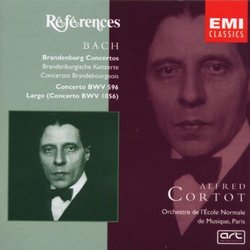| All Artists: Johann Sebastian Bach, Alfred Cortot Title: Bach: Brandenburg Concertos Members Wishing: 0 Total Copies: 0 Label: EMI Classics Imports Release Date: 1/11/2000 Genre: Classical Styles: Forms & Genres, Concertos, Historical Periods, Baroque (c.1600-1750), Symphonies Number of Discs: 2 SwapaCD Credits: 2 UPC: 724356721128 |
Search - Johann Sebastian Bach, Alfred Cortot :: Bach: Brandenburg Concertos
 | Johann Sebastian Bach, Alfred Cortot Bach: Brandenburg Concertos Genre: Classical
|
Larger Image |
CD Details |
CD ReviewsAlfred Cortot, the Ecole Normale and Bach Peter G. Watchorn | Cambridge, MA USA | 09/26/2003 (5 out of 5 stars) "This series of recordings was first issued in the early 1930's on red label HMV 78s. It was literally the first complete set of the Brandenburg Concertos ever recorded (pre-dating the famous Busch Chamber Players version by a couple of years). The Chamber orchestra of the Paris Ecole Normale, which Alfred Cortot had founded in 1918, was an ensemble of students and staff put together by Cortot for these sessions.These are astonishing performances and are well worth a detailed listen, particularly for those who find, as I do, that Cortot was one of the most fascinating musical figures of the twentieth century. First, for sheer lightness and speed, many of Cortot's readings are unique for their time (the Busch set is often heavy and literal in comparison). The pointed articulation and directness of speech imparted by Cortot and matched by his players approaches that of many later "period instrument" ensembles. And when Cortot takes the odd liberty with the score (use of pizzicato in the bass part, for example), it is always to clarify the voice leading and render the music more articulate (Gustav Leonhardt, in his distinguished 1977 recording of these works, made over forty years later, achieved the same effect through use of "period" instruments and the fine articulation which they demand). Cortot's are performances of amazing energy and directness, often astonishingly modern in their outlook, and timeless in their musicianship. Many features of Cortot's insightful musical approach were not explored further until the 1960's, with the advent of the "historical performance" movement. Cortot was, truly, a musician far ahead of his time.Of course, there are idiosyncracies, too, like Cortot's habit of placing big ritardandi towards the end of the ritornelli (for example, in the opening movements of concertos 2, 4 and 5. However, listen to the slow movement of no. 2, where the "alberti bass" is played "detache", as a simple harmonic framework, just as Leonhardt did it over forty years after this was recorded. In the outer movements of no. 2, Cortot's trumpet soloist tackles the difficult part as written (it was common at that time to transpose it down an octave, a la Stokowski, or play it on another instrument entirely, as did Toscanini). As piano soloist, Cortot is joined in the fifth concerto by his long-time trio partner, violinist Jacques Thibaud, as well as by the distinguished flautist, Roger Cortet. It is an amazing performance indeed. Cortot's playing of the great 65-bar cadenza is, simply, unrivalled.This set is musically fascinating as well as a unique historical document. As a window providing insight into Cortot's extraordinary musical instincts and his concern with historical accuracy, it is invaluable - and unique.The concertos were all performed using harpsichord continuo (Busch used piano throughout), except in No. 5, where Cortot played the harpsichord part on the piano. His extraordinary performance (with the 32nd note "fantasia" section played in octaves!) almost convinces you that the harpsichord is inadequate to the task (I'm a harpsichordist!), and his use of over-legato and fine articulation reveals all sorts of beauties and intricacies in the music. It would be nice to be able to definitively report that Cortot himself played the harpsichord continuo in the other concertos, but this is unconfirmed (though suspected - it's very well played, rhythmical and often quite inventive - witness the slow movement of the second concerto). The harpsichord used is, of course, a Pleyel.To be sure, the standards of ensemble are fairly rough and ready on occasion, but the spirit is there, loud and clear. So, forget about the historical nature of the recorded sound and the odd technical blemish here and there (of course, all these performances are "live" and unedited). Those who wish to know more about Bach, Cortot and twentieth century performance should invest in this set. It is, simply, unique. And totally rewarding. Strongly recommended." Reprint of 1929 recording is scratchy, raw. H. Quinn | 03/06/2000 (3 out of 5 stars) "Only hard-core Bach afficionados looking specifically for the Cortot recordings should invest their money here. These concertos were recorded in 1929 and so the poor quality and scratchiness of the recordings entered my head like water when I was expecting wine. It's good music only if you're willing to accept its raw sound. If you're only a casual listener (like me), skip this CD and buy a recent recording that contains the depth of sound that only today's recording equipment can capture."
|

 Track Listings (13) - Disc #1
Track Listings (13) - Disc #1